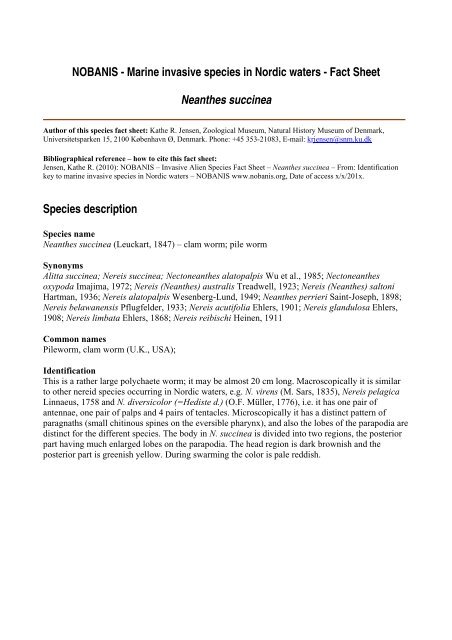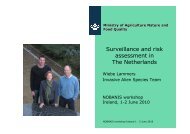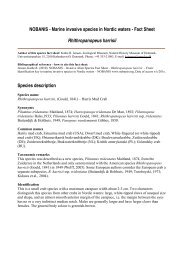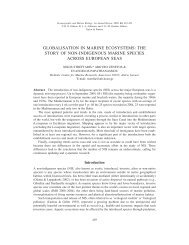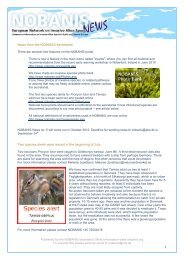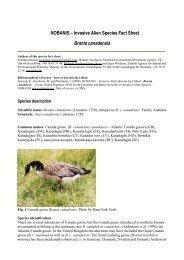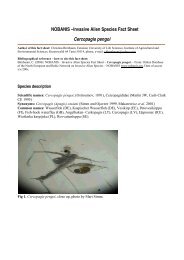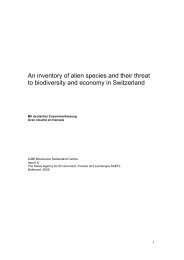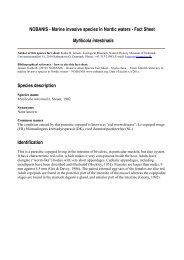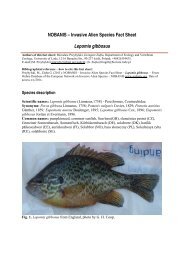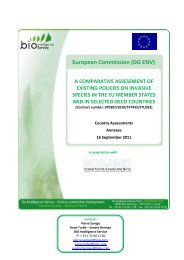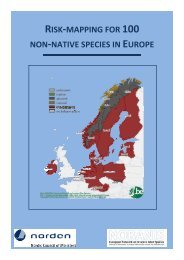NOBANIS - Marine invasive species in Nordic waters - Fact Sheet
NOBANIS - Marine invasive species in Nordic waters - Fact Sheet
NOBANIS - Marine invasive species in Nordic waters - Fact Sheet
Create successful ePaper yourself
Turn your PDF publications into a flip-book with our unique Google optimized e-Paper software.
<strong>NOBANIS</strong> - <strong>Mar<strong>in</strong>e</strong> <strong><strong>in</strong>vasive</strong> <strong>species</strong> <strong>in</strong> <strong>Nordic</strong> <strong>waters</strong> - <strong>Fact</strong> <strong>Sheet</strong><br />
Neanthes succ<strong>in</strong>ea<br />
Author of this <strong>species</strong> fact sheet: Kathe R. Jensen, Zoological Museum, Natural History Museum of Denmark,<br />
Universitetsparken 15, 2100 København Ø, Denmark. Phone: +45 353-21083, E-mail: krjensen@snm.ku.dk<br />
Bibliographical reference – how to cite this fact sheet:<br />
Jensen, Kathe R. (2010): <strong>NOBANIS</strong> – Invasive Alien Species <strong>Fact</strong> <strong>Sheet</strong> – Neanthes succ<strong>in</strong>ea – From: Identification<br />
key to mar<strong>in</strong>e <strong><strong>in</strong>vasive</strong> <strong>species</strong> <strong>in</strong> <strong>Nordic</strong> <strong>waters</strong> – <strong>NOBANIS</strong> www.nobanis.org, Date of access x/x/201x.<br />
Species description<br />
Species name<br />
Neanthes succ<strong>in</strong>ea (Leuckart, 1847) – clam worm; pile worm<br />
Synonyms<br />
Alitta succ<strong>in</strong>ea; Nereis succ<strong>in</strong>ea; Nectoneanthes alatopalpis Wu et al., 1985; Nectoneanthes<br />
oxypoda Imajima, 1972; Nereis (Neanthes) australis Treadwell, 1923; Nereis (Neanthes) saltoni<br />
Hartman, 1936; Nereis alatopalpis Wesenberg-Lund, 1949; Neanthes perrieri Sa<strong>in</strong>t-Joseph, 1898;<br />
Nereis belawanensis Pflugfelder, 1933; Nereis acutifolia Ehlers, 1901; Nereis glandulosa Ehlers,<br />
1908; Nereis limbata Ehlers, 1868; Nereis reibischi He<strong>in</strong>en, 1911<br />
Common names<br />
Pileworm, clam worm (U.K., USA);<br />
Identification<br />
This is a rather large polychaete worm; it may be almost 20 cm long. Macroscopically it is similar<br />
to other nereid <strong>species</strong> occurr<strong>in</strong>g <strong>in</strong> <strong>Nordic</strong> <strong>waters</strong>, e.g. N. virens (M. Sars, 1835), Nereis pelagica<br />
L<strong>in</strong>naeus, 1758 and N. diversicolor (=Hediste d.) (O.F. Müller, 1776), i.e. it has one pair of<br />
antennae, one pair of palps and 4 pairs of tentacles. Microscopically it has a dist<strong>in</strong>ct pattern of<br />
paragnaths (small chit<strong>in</strong>ous sp<strong>in</strong>es on the eversible pharynx), and also the lobes of the parapodia are<br />
dist<strong>in</strong>ct for the different <strong>species</strong>. The body <strong>in</strong> N. succ<strong>in</strong>ea is divided <strong>in</strong>to two regions, the posterior<br />
part hav<strong>in</strong>g much enlarged lobes on the parapodia. The head region is dark brownish and the<br />
posterior part is greenish yellow. Dur<strong>in</strong>g swarm<strong>in</strong>g the color is pale reddish.
Neanthes succ<strong>in</strong>ea, full body. Photo by Kathe Rose Jensen<br />
Neanthes succ<strong>in</strong>ea, close-up. Photo by Kathe Rose Jensen
Neanthes succ<strong>in</strong>ea (from Kirkegaard 1992)<br />
A: Anterior end with everted proboscis show<strong>in</strong>g jaws and paragnaths. Arrow po<strong>in</strong>ts to group of<br />
paragnaths that are specific for this <strong>species</strong>.<br />
B: Parapodium from anterior end.<br />
C: Parapodium from posterior end with enlarged dorsal lobe.<br />
The three common <strong>species</strong> also have different reproductive patterns (see below).<br />
http://www.<strong><strong>in</strong>vasive</strong><strong>species</strong>.net/database/<strong>species</strong>/ecology.asp?si=1068&fr=1&sts=&lang=EN,<br />
http://adl.brs.gov.au/mar<strong>in</strong>epests/<strong>in</strong>dex.cfm?fa=ma<strong>in</strong>.spDetailsDB&sp=6000005300,<br />
http://www.padil.gov.au/viewPestDiagnosticImages.aspx?id=547<br />
For Neanthes virens (=Alitta v.; =Nereis v.), K<strong>in</strong>g ragworm, see<br />
http://<strong>species</strong>-identification.org/<strong>species</strong>.php?<strong>species</strong>_group=macrobenthos_polychaeta&id=722<br />
For Neanthes pelagica (=Nereis p.), see<br />
http://<strong>species</strong>-identification.org/<strong>species</strong>.php?<strong>species</strong>_group=macrobenthos_polychaeta&id=720<br />
For Hediste diversicolor (=Nereis d.), Common ragworm, see<br />
http://<strong>species</strong>-identification.org/<strong>species</strong>.php?<strong>species</strong>_group=macrobenthos_polychaeta&id=715,<br />
http://www.marl<strong>in</strong>.ac.uk/<strong>species</strong>fullreview.php?<strong>species</strong>ID=3470
Distribution<br />
Native distribution<br />
This is a cryptogenic <strong>species</strong>. It was orig<strong>in</strong>ally described from Helgoland <strong>in</strong> 1847 (Bakken &<br />
Wilson, 2005), but it took almost 100 years before it was recorded <strong>in</strong> other places. However, Wolff<br />
(1973) claims that it may have been present <strong>in</strong> the Netherlands s<strong>in</strong>ce the 18th century, and there are<br />
museum records from 1899.<br />
Introduced distribution<br />
This <strong>species</strong> is found almost worldwide, but has been considered native of the North(east) Atlantic<br />
and then <strong>in</strong>troduced to other regions. It was first recorded from Danish <strong>waters</strong> <strong>in</strong> 1953, but later a<br />
few specimens, which had been collected <strong>in</strong> 1949, were found <strong>in</strong> the Zoological Museum,<br />
Copenhagen (Muus, 1967). It was first found <strong>in</strong> Sweden on the west coast <strong>in</strong> 1940 (Smith, 1963). It<br />
is often associated with mussel beds (Muus, 1967; Rasmussen, 1973).<br />
On the west coast of the USA N. succ<strong>in</strong>ea lives <strong>in</strong> a land-locked salt-lake, Salton Sea, below sea<br />
level (Kuhl & Oglesby, 1979).<br />
The <strong>species</strong> recorded as Nereis succ<strong>in</strong>ea <strong>in</strong> the Caspian Sea has turned out to be Hediste<br />
diversicolor (=Nereis d.) (Muus, 1967).<br />
Neanthes succ<strong>in</strong>ea occurs <strong>in</strong> Iranean Gulf (as Nereis alatopalpis) and <strong>in</strong> southeastern Australia,<br />
where it was first recorded <strong>in</strong> 1978 (Hewitt et al., 2004).<br />
Ecology<br />
N. succ<strong>in</strong>ea is a deposit-feeder preferentially <strong>in</strong>habit<strong>in</strong>g soft bottoms from <strong>in</strong>tertidal to about 20 m<br />
depth (Wolff, 1973). It may also be a voracious predator or scavenger, feed<strong>in</strong>g on amphipods or<br />
other small <strong>in</strong>vertebrates (Rasmussen, 1973; Hardege et al., 1990). It burrows <strong>in</strong> the sediment and<br />
may form semi-permanent U-shaped tubes or complex gallery burrows, depend<strong>in</strong>g on the sediment<br />
(Rasmussen, 1973; Kirkegaard, 1992). It may occur <strong>in</strong> densities of 600 <strong>in</strong>dividuals per m²<br />
(Rasmussen, 1973). It is highly tolerant for k<strong>in</strong>ds of pollution and extremely euryhal<strong>in</strong>e (Kuhl &<br />
Oglesby, 1979) and is able to take up sediment-associated pollutants through the gut (Ahrens et al.,<br />
2001). It is often associated with mussel and oyster beds. It is an excellent food for many fish<br />
<strong>species</strong> (Carpelan & L<strong>in</strong>sley, 1961; Neuhoff, 1979), and is also used for bait by sport fishermen.<br />
Dur<strong>in</strong>g swarm<strong>in</strong>g they are often prey of sea birds from above and jellyfish from below (Rasmussen,<br />
1973).<br />
Reproduction<br />
In N. succ<strong>in</strong>ea both sexes show swarm<strong>in</strong>g behavior <strong>in</strong> connection with reproduction. Swarm<strong>in</strong>g<br />
takes place <strong>in</strong> the summer at temperatures above 13° C, and usually dur<strong>in</strong>g the night at new moon<br />
(Kirkegaard, 1992), though it occurred <strong>in</strong> bright sunsh<strong>in</strong>e <strong>in</strong> the Isefjord (Rasmussen, 1973). The<br />
the Salton Sea swarm<strong>in</strong>g does not seem to follow a monthly cycle (Carpelan & L<strong>in</strong>sley, 1972). In<br />
N. virens only the males form “heteronereis” or epitoke body forms with enlanrged parapodial lobes<br />
on part of the body (Bass & Brafield, 1972). H. diversicolor does not change <strong>in</strong> body form <strong>in</strong><br />
connection with reproduction (Kirkegaard, 1992). In all three <strong>species</strong> the worms die soon after<br />
spawn<strong>in</strong>g (Muus, 1967; Kirkegaard, 1992). Spawn<strong>in</strong>g period for N. succ<strong>in</strong>ea is June to September,<br />
for N. virens April to May, and for H. diversicolor June to August (Neuhoff, 1979). Gonads mature<br />
while the animals are still <strong>in</strong> their tubes while they wait for the adequate signal to <strong>in</strong>itiate swarm<strong>in</strong>g
(Hardege et al., 1990). The body is divided <strong>in</strong>to 3 regions dur<strong>in</strong>g the swarm<strong>in</strong>g period; only the<br />
middle section is used for swimm<strong>in</strong>g. Males are bright red <strong>in</strong> the middle section and females<br />
greenish brown (Rasmussen, 1973). Many studies have been carried out on the role of pheromones<br />
<strong>in</strong> the reproduction of this <strong>species</strong> (Zeeck et al., 1990; Ram et al., 1999, 2008; Watson et al., 2003;<br />
Hardege et al., 2004). Swarm<strong>in</strong>g is controlled by temperature and lunar phase (Hardege et al.,<br />
1990).<br />
Impacts<br />
As it is considered native <strong>in</strong> many European countries, impacts have not been identified except for<br />
Australia and the west coast of the USA. It has a high potential for bioturbation and the impacts<br />
associated with this, e.g. oxygenation <strong>in</strong> deeper layers, bioavailability of pollutants buried <strong>in</strong> the<br />
sediment, <strong>in</strong>creased activity of meiofauna and micro-organisms. It is able to bioaccumulate a<br />
number of pollutants and may be used as a biomonitor. Competition with other nereid <strong>species</strong> has<br />
been suggested as H. diversicolor seems to become rare where N. succ<strong>in</strong>ea becomes common<br />
(Smith, 1963).<br />
Nereis succ<strong>in</strong>ea and the other nereid <strong>species</strong> are commonly used as bait.<br />
References<br />
Ahrens, M.J., Hertz, J., Lamoureux, E.M., Lopez, G.R., McElroy, A.E. and Brownawell, B.J. 2001. The effect of body<br />
size on digestive chemistry and absorption efficiencies of food and sediment-bound organic contam<strong>in</strong>ants <strong>in</strong> Nereis<br />
succ<strong>in</strong>ea (Polychaeta). Journal of Experimental <strong>Mar<strong>in</strong>e</strong> Biology and Ecology 263: 185-209.<br />
Bakken, T. and Wilson, R.S. 2005. Phylogeny of nereidids (Polychaeta, Nereididae) with paragnaths. Zoologica Scripta<br />
34: 507-547.<br />
Bartoli, M., Nizzoli, D., Welsh, D.T. and Viaroli, P. 2000. Short-term <strong>in</strong>fluence of recolonisation by the polychaete<br />
worm Nereis succ<strong>in</strong>ea on oxygen and nitrogen fluxes and denitrification: a microcosm simulation. Hydrobiologia 431:<br />
165-174.<br />
Bass, N.R. and Brafield, A.E. 1972. The life-cycle of the polychaete Nereis virens. Journal of the <strong>Mar<strong>in</strong>e</strong> Biological<br />
Association of the United K<strong>in</strong>gdom 52: 701-726.<br />
Briggs, K.B., Tenore, K.R. and Hanson, R.B. 1979. The rôle of microfauna <strong>in</strong> detrital utilization by the polychaete,<br />
Nereis succ<strong>in</strong>ea (Frey and Leuckart). Journal of Experimental <strong>Mar<strong>in</strong>e</strong> Biology and Ecology 36: 225-234.<br />
Carpelan, L.H. and L<strong>in</strong>sley, R.H. 1961. The spawn<strong>in</strong>g of Neanthes succ<strong>in</strong>ea <strong>in</strong> the Salton Sea. Ecology 42(1): 189-190.<br />
Hardege, J.D., Bartels-Hardege, H., Müller, C.T. and Beckmann, M. 2004. Peptide pheromones <strong>in</strong> female Nereis<br />
succ<strong>in</strong>ea. Peptides 25: 1517-1522.<br />
Hardege, J.D., Bartels-Hardege, H.D., Zeeck, E. and Grimm, F.T. 1990. Induction of swarm<strong>in</strong>g of Nereis succ<strong>in</strong>ea.<br />
<strong>Mar<strong>in</strong>e</strong> Biology 104: 291-295.<br />
Horst, R. 1922. Een heteronereis-vorm van Nereis succ<strong>in</strong>ea Leuck. Zoologische Mededeel<strong>in</strong>gen 7: 40.<br />
Kirkegaard, J.B. 1992. Havbørsteorme I. Errantia. Danmarks Fauna 83: 1-416.<br />
Kristensen, E. 1983a. Ventilation and oxygen uptake by three <strong>species</strong> of Nereis (Annelida: Polychaeta). I. Effects of
hypoxia. <strong>Mar<strong>in</strong>e</strong> Ecology Progress Series 12: 289-297.<br />
Kristensen, E. 1983b. Ventilation and oxygen uptake by three <strong>species</strong> of Nereis (Annelida: Polychaeta). II. Effects of<br />
temperature and sal<strong>in</strong>ity changes. <strong>Mar<strong>in</strong>e</strong> Ecology Progress Series 12: 299-306.<br />
Kuhl, D.L. and Oglesby, L.C. 1979. Reproduction and survival of the pileworm Nereis succ<strong>in</strong>ea <strong>in</strong> higher Salton Sea<br />
sal<strong>in</strong>ities. Biological Bullet<strong>in</strong> 157: 153-165.<br />
Müller, C.T., Priesnitz, F.M. and Beckmann, M. 2005. Pheromonal communication <strong>in</strong> nereids and the likely<br />
<strong>in</strong>tervention by petroleum derived pollutants. Integrative and Comparative Biology 45: 189-193.<br />
Muus, B.J. 1967. The fauna of Danish estuaries and lagoons. Meddelelser fra Danmarks Fiskeri- og Havundersøgelser<br />
5: 1-316.<br />
Neuhoff, H.-G. 1979. Effects of seasonally vary<strong>in</strong>g factors on a Nereis succ<strong>in</strong>ea population (Polychaeta, Annelida).<br />
<strong>Mar<strong>in</strong>e</strong> Ecology Progress Series 1: 263-268.<br />
NIMPIS (National Introduced <strong>Mar<strong>in</strong>e</strong> Pest Information System) 2010. Alitta succ<strong>in</strong>ea (pileworm). <strong>Fact</strong> sheet available<br />
at http://adl.brs.gov.au/mar<strong>in</strong>epests/<strong>in</strong>dex.cfm?fa=ma<strong>in</strong>.spDetailsDB&sp=6000005300 (accessed on 16 April 2010).<br />
Pardo, E.V. and Dauer, D.M. 2003. Particle size selection <strong>in</strong> <strong>in</strong>dividuals from epifaunal versus <strong>in</strong>faunal populations of<br />
the nereidid polychaete Neanthes succ<strong>in</strong>ea (Polychaeta: Nereididae). Hydrobiologia 496: 355-360.<br />
Ram, J.L., Fei, X., Danaher, S.M., Lu, S., Breithaupt, T. and Hardege, J.D. 2008. F<strong>in</strong>d<strong>in</strong>g females: pheromone-guided<br />
reproductive track<strong>in</strong>g behavior by male Nereis succ<strong>in</strong>ea <strong>in</strong> the mar<strong>in</strong>e environment. Journal of Experimental Biology<br />
211: 757-765.<br />
Ram, J.L., Müller, C.T., Beckmann, M. and Hardege, J.D. 1999. The spawn<strong>in</strong>g pheromone cyste<strong>in</strong>e-glutathione<br />
disulfide (‘nereithione’) arouses a multicomponent nuptial behavior and electrophysiological activity <strong>in</strong> Nereis succ<strong>in</strong>ea<br />
males. FASEB Journal 13: 945-952.<br />
Rasmussen, E. 1973. Systematics and ecology of the Isefjord mar<strong>in</strong>e fauna (Denmark). Ophelia 11: 1-507.<br />
Smith, R.I. 1963. On the occurrence of Nereis (Neanthes) succ<strong>in</strong>ea at the Krist<strong>in</strong>eberg Zoological Station, Sweden, and<br />
its recent northwards spread. Arkiv för Zoologi 15: 437-441.<br />
Swan, B.K., Watts, J.M., Reifel, K.M. and Hurlbert, S.H. 2007. Role of the polychaete Neanthes succ<strong>in</strong>ea <strong>in</strong><br />
phosphorus regeneration from sediments <strong>in</strong> the Salton Sea, California. Hydrobiologia 576: 111-125.<br />
Wang, W.-X-. Stupakoff, I. and Fisher, N.S. 1999. Bioavailability of dissolved and sediment-bound metals to a mar<strong>in</strong>e<br />
deposit-feed<strong>in</strong>g polychaete. <strong>Mar<strong>in</strong>e</strong> Ecology Progress Series 178: 281-293.<br />
Watson, G.J., Bentley, M.G., Gaudron, S.M. and Hardege, J.D. 2003. The role of chemical signals <strong>in</strong> the spawn<strong>in</strong>g<br />
<strong>in</strong>duction of polychaete worms and other mar<strong>in</strong>e <strong>in</strong>vertebrates. Journal of Experimental <strong>Mar<strong>in</strong>e</strong> Biology and Ecology<br />
294: 169-187.<br />
Wolff, W.J. 1973. The estuary as a habitat. An analysis of data on the soft-bottom macrofauna of the estuar<strong>in</strong>e area of<br />
the rivers Rh<strong>in</strong>e, Meuse, and Scheldt. Zoologische Verhandel<strong>in</strong>gen 126: 3-242.<br />
Zeeck, E., ardege, J. and Bartels-Hardege, H. 1990. Sex pheromones and reproductive isolation <strong>in</strong> two nereid <strong>species</strong>,<br />
Nereis succ<strong>in</strong>ea and Platynereis dumerilii. <strong>Mar<strong>in</strong>e</strong> Ecology Progress Series 67: 183-188.


